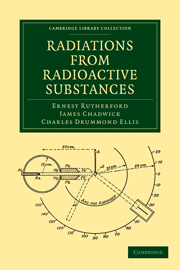Book contents
- Frontmatter
- Contents
- LIST OF PLATES
- Preface
- Chap. I Radioactive Transformations
- Chap. II The α Rays
- Chap. III Absorption of the α Rays
- Chap. IV Some Properties of the α Particle
- Chap. V Theories of Absorption of α Rays
- Chap. VI Secondary Effects produced by α Rays
- Chap. VII General Properties of the Radiations
- Chap. VIII The Scattering of α and β Particles
- Chap. IX The Collisions of α Particles with Light Atoms
- Chap. X The Artificial Disintegration of the Light Elements
- Chap. XI The Radioactive Nuclei
- Chap. XII β Ray and γ Ray Spectra
- Chap. XIII The Disintegration Electrons
- Chap. XIV The Passage of β Particles through Matter
- Chap. XV The Scattering and Absorption of γ Rays
- Chap. XVI Intensity Problems connected with the Emission of γ Rays
- Chap. XVII Atomic Nuclei
- Chap. XVIII Miscellaneous
- Appendix
- Subject Index
- Index of Names
- Plate section
Chap. XV - The Scattering and Absorption of γ Rays
Published online by Cambridge University Press: 07 September 2010
- Frontmatter
- Contents
- LIST OF PLATES
- Preface
- Chap. I Radioactive Transformations
- Chap. II The α Rays
- Chap. III Absorption of the α Rays
- Chap. IV Some Properties of the α Particle
- Chap. V Theories of Absorption of α Rays
- Chap. VI Secondary Effects produced by α Rays
- Chap. VII General Properties of the Radiations
- Chap. VIII The Scattering of α and β Particles
- Chap. IX The Collisions of α Particles with Light Atoms
- Chap. X The Artificial Disintegration of the Light Elements
- Chap. XI The Radioactive Nuclei
- Chap. XII β Ray and γ Ray Spectra
- Chap. XIII The Disintegration Electrons
- Chap. XIV The Passage of β Particles through Matter
- Chap. XV The Scattering and Absorption of γ Rays
- Chap. XVI Intensity Problems connected with the Emission of γ Rays
- Chap. XVII Atomic Nuclei
- Chap. XVIII Miscellaneous
- Appendix
- Subject Index
- Index of Names
- Plate section
Summary
§ 102. The discovery of the penetrating radiations known as the γ rays was made by observations of the ionisation in an electroscope, and an idea of the penetrating power was obtained by placing a screen of absorbing material between the source and the electroscope. In this way it was found that these radiations were far more penetrating than the β rays, a centimetre of lead being required in some cases to reduce the ionising effect to one-half. It was observed that the γ rays in passing through matter gave rise to swift β rays, and the ionisation in the electroscope was ascribed to β rays liberated from the walls and the gas.
The chief source of γ radiation in the early experiments was radium (B + C), and a number of experiments were made to test the law of absorption by the simple method outlined above. While it was found that with considerable thicknesses the absorption curve approximated closely to a simple exponential law, yet with small thicknesses a greater absorbability was noticed. This led naturally to the deduction that a large part of the radiation was homogeneous in character and that superimposed on this were softer radiations which were more rapidly absorbed.
Systematic observations were made by Soddy and Russell of the absorption of different metals which showed that for the lighter elements the absorption depended only on the mass per square centimetre of the absorber and did not vary with the atomic weight. For the heavier elements such as lead the absorption was twice as great as would have been expected from the results with the light elements.
Information
- Type
- Chapter
- Information
- Radiations from Radioactive Substances , pp. 451 - 494Publisher: Cambridge University PressPrint publication year: 2010First published in: 1930
